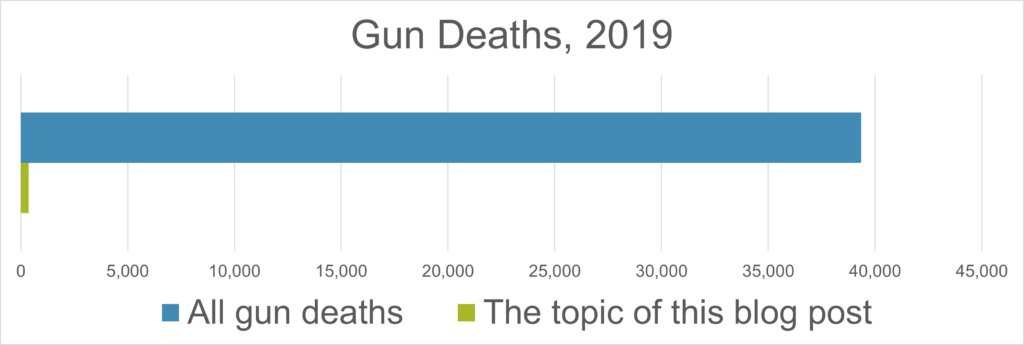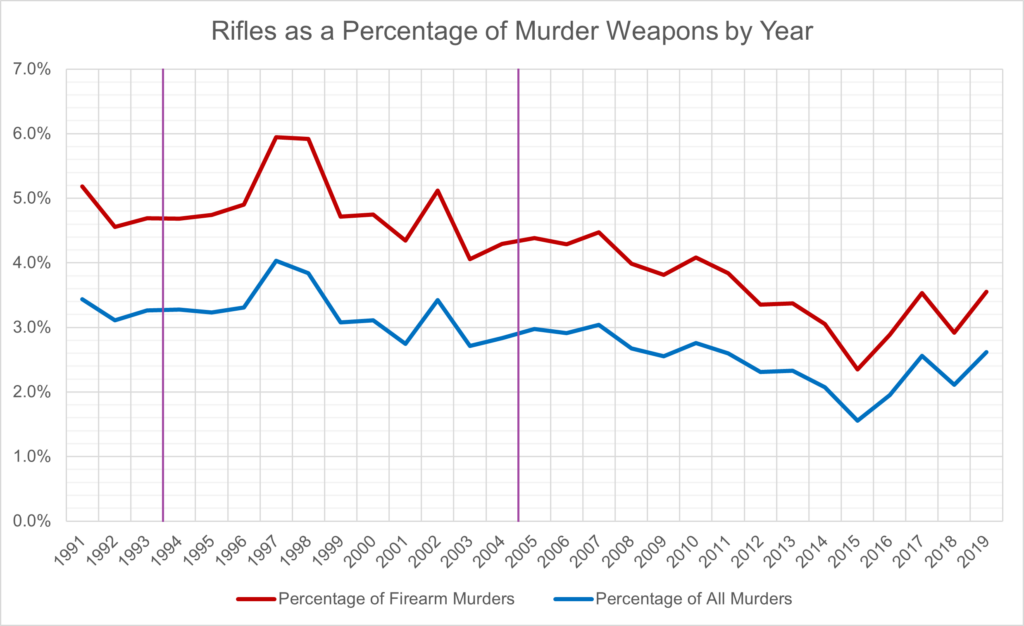Gun Control Supporters Should Oppose “Assault Weapon” Bans

TL;DR
This week’s blog post is unusually long (more like a short essay), so I’ll deliver the punchline upfront and let you continue reading if you’re still interested in what I have to say. “Assault weapon” bans are pointless, and I can prove it mathematically. They don’t work, and even if they did, they would still be laughably ineffective.
Introduction
With the passage of HB 5471 this past Tuesday, Illinois became the ninth state to impose a ban on so-called “assault weapons.” Governor J.B. Pritzker hailed the measure as “a step in the right direction, to improve safety for Illinois’ families and law enforcement;” several Illinois politicians and anti-gun lobbyists lavished similar praise on the bill.
But is this really a win for public safety? In the ongoing political war over gun control, “assault weapon” bans have been the subject of intense scrutiny, with many experts raising questions about the efficacy and legality of such laws. As a longtime Second Amendment activist, I have done extensive research into the various minutiae of “assault weapon” bans to expose them as what they are: bad public policy. Gun control supporters already expect us on the pro-gun side to tell them why we oppose such measures, so in this post, I’ll take a different tack and explain why “assault weapon” bans conflict with their own views.
I’m Afraid We Need to Use… Math
The gun control debate is somewhat unusual among hot-button issues in that both sides fundamentally agree on the same goal: to save lives. Using the number of lives saved as a way to keep score, let’s examine the efficacy of a hypothetical 100% effective “assault weapon” ban, using official U.S. government data. Because this is a thought experiment, unburdened by reality, we’ll be giving our ban the benefit of the doubt at every turn—it will be maximally restrictive and impossible for anyone to disobey.
First, let’s look at how many people are killed with firearms in the United States each year. Contrary to popular belief, the CDC researches and publishes detailed statistics on the topic, and according to their data, 39,707 people died from firearm-related injuries in 2019. If death by firearm regardless of circumstance was considered one cause of death, it would be the 10th most prevalent, behind kidney disease. Of those 39,707 deaths, 60.3% were suicides, 36.3% were homicides, and 3.4% were accidents. As a crime prevention bill, our hypothetical ban would target some subset of that 36.3%.
Multiple studies have shown that the overwhelming majority of firearms used in violent crimes are not legally owned by the perpetrator, and that criminals who use firearms in crimes have a much higher recidivism rate than those who do not. In other words, laws restricting legal access to firearms have little effect on the people who actually commit crimes with them. Our hypothetical gun ban conveniently ignores that fact, however; we’re assuming that it will make all “assault weapons” vanish overnight. How many of them, then, are actually used in that 36.3% of homicides?
“Assault Weapons” Are Rarely Used in Crimes
The FBI compiles crime data from law enforcement across the country and publishes it in a comprehensive annual report, the most recent of which at the time of writing is from 2019. Included in that report is a very helpful breakdown of the number of murders (not including justifiable homicides) committed with different types of weapons. Of the nearly 14,000 total murder victims that year, just 364 were identified to have been killed with rifles of any type—not just “assault weapons,” but hunting and target rifles, too. That’s 3.6% of gun murders and just 1.3% of all firearm-related deaths. Just to give our hypothetical gun ban every possible statistical advantage, though, let’s extrapolate and assume a comparable proportion of unidentified firearms used in these crimes were also rifles, bringing the number up to an estimated 535. To further manipulate the statistics in favor of the ban, we’ll also make the incorrect assumption that “assault weapons” are the only rifles ever used in murders.

None of this should be misconstrued to suggest that these deaths are anything but tragic, but the fact of the matter is, our hypothetical 100% effective “assault weapon” ban would have a minuscule effect on the overall statistics. That’s even if it accounted for every rifle used in a murder (it wouldn’t), even if such a bill was possible to fully enforce (it isn’t), even if it worked against firearms that were already illegally owned (it wouldn’t), and even if there were no negative consequences (which there most certainly would be). Decades of lies and lobbying, the protracted propaganda campaign to demonize a made-up class of firearm and those who own them, and dozens of bills passed since California began the trend in 1989, all to reduce the firearm death rate by a whopping 1.3%—and that’s if it worked.


Would it, though? The Federal Assault Weapons Ban, which was in effect from 1994 to 2004, attempted to do just this. While the number of firearm homicides decreased during this time, that’s only part of the story. That number peaked before the ban took effect, decreased with overall crime rates in the early 1990s, then stabilized for more than a decade and a half. Regarding the actual focus of the bill, the percentage of murders committed with rifles was higher during the ban than it had been the year before it took effect and similar or lower after it expired. In simpler terms, you were more likely to be killed with a rifle during the Federal Assault Weapons Ban.
Conclusion
It is abundantly clear that even beyond their myriad other flaws, “assault weapon” bans don’t work, and even if they did, their effect would be utterly minuscule. There are innumerable other laws and policies that would make a much larger positive impact while preserving our rights. Even if you still consider yourself a supporter of gun control, this data should make you change your approach. Stop advocating for ridiculous laws that do nothing to keep people safe; instead, call for better enforcement of existing laws. Stop blaming and punishing law-abiding citizens for the actions of criminals. If you insist on supporting anti-gun lobbying organizations, ask their leadership the tough questions about the policies they push and whether their reasoning is backed by hard data.
For those of you who are already pro-gun, be polite to our ideological adversaries. Continue reaching out to educate people about why we believe what we believe. Share this blog post with your uninformed friends to help them understand our point of view and make better political decisions. I, for one, am tired of having to debunk the same unfounded anti-gun arguments over and over again—maybe if we can educate the other side a little, we’ll they’ll give us some new and interesting myths to bust.
